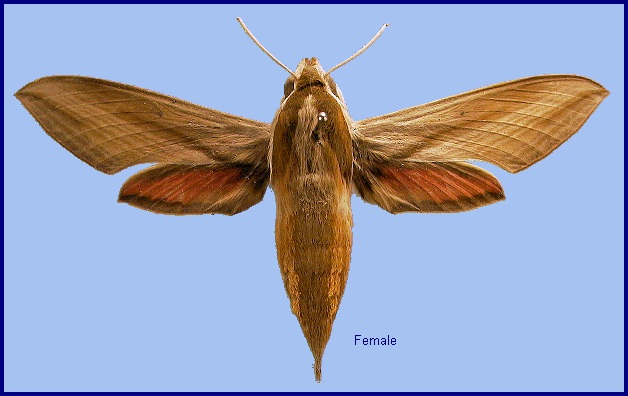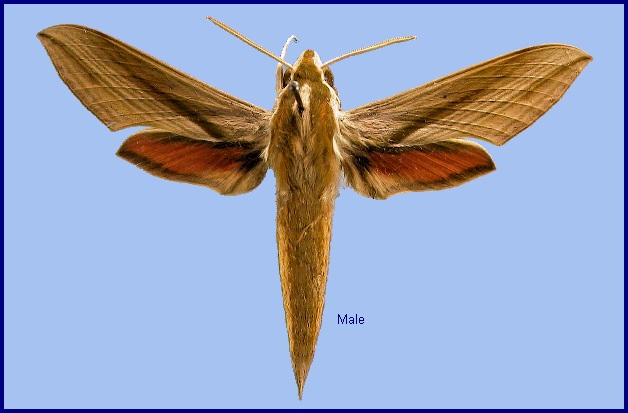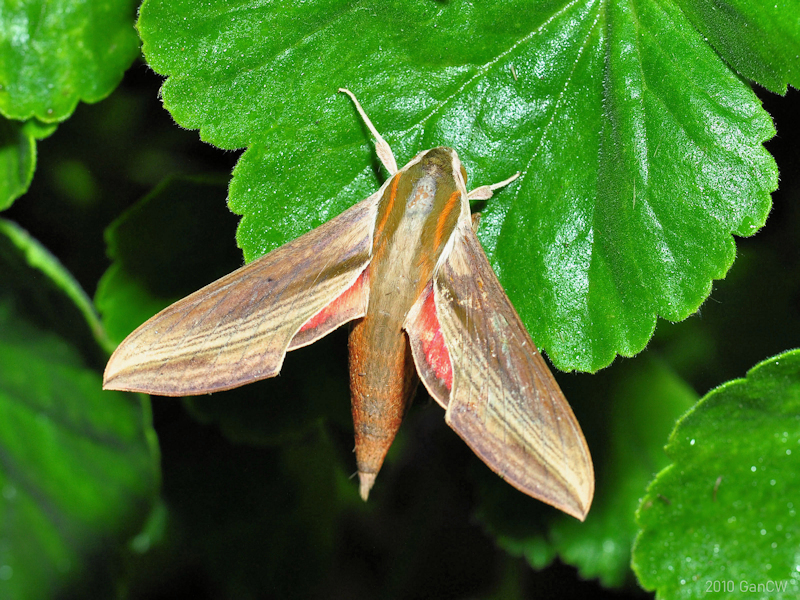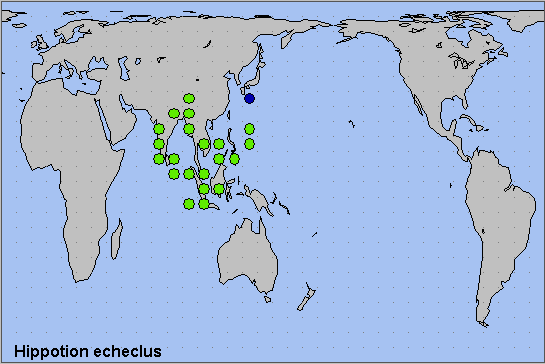

Choerocampa echeclus Boisduval, [1875], in: Boisduval & Guenée, Hist. nat. Insectes (Spec. gén. Lépid. Hétérocères) 1: 233. Type locality: Philippines, <<Manila>>.
Synonym. Choerocampa echeclus Boisduval, [1875].
Synonym. Chaerocampa elegans Butler, 1875.
[Further details on this species in Japan, as well as photos of many stages, can be found on Digital Moths of Japan.]
Wingspan: 64--84mm. Forewing upperside similar to Hippotion boerhaviae and Hippotion gracilis but the oblique postmedian band very pale, appearing to divide the wing into three sections. Hindwing orange-pink with a black basal patch and a brown marginal band; tornal area buff. Upperside of thorax with a pale grey medial stripe. Most similar to Hippotion boerhaviae, Hippotion rafflesii rafflesii and Hippotion rosetta but immediately distinguishable by the black base to the hindwing upperside. In this respect, Hippotion echeclus resembles a small Hippotion gracilis from which it can be distinguished by male genital structure.
In the male genitalia, uncus much stouter than in Hippotion eson, sinuate. Gnathos triangular, tapering to a point, apex upcurved, almost hooked. Harpe globose with an apiculate thorn-like process and one or more teeth on the ventral edge; dorsal edge with long scales. Phallus with a curved row of teeth on the left and a few subapical teeth on the right; no process. In the female genitalia, ostium bursae as in Hippotion eson but the ridge around the ostium not as distinct and gradually reducing.

In India, rare in areas with a heavy rainfall, but fairly common in dry areas and sometimes very abundant locally. The moth does not appear to be attracted by light (Bell & Scott, 1937).
Japan: 10.vii (Ryukyu Archipelago).
OVUM:
LARVA: Full-fed 60mm, width 9 mm., horn 2 mm. According to Bell & Scott (1937), in the final instar shape as in others of the genus. Horn very short, straight, stout at base and tapering sharply to a point. Surface of body smooth and dull. In the green form, head glaucous-green, basal segment of antenna pale green, other segments pink. Body grass green; dorsum of segments 6 to 11 marked with short, narrow, darker stripes on each secondary ring. On segment 5 there is a large oval, dorso-lateral eye-spot, the oval pupil pale green above shading to dark green below, edged broadly with yellow and narrowly with black. There is also an eye-spot on 6 about two-thirds as long and as broad as that on 5, pupil yellow above with a dark green spot on the upper edge, green below, the whole edged narrowly with dark green. A similarly coloured but still smaller eye-spot occurs on 7, but on 8 to 11 only the dark green spot remains. There is an obscure yellowish dorso-lateral stripe running from behind the eye-spot on 6 to base of horn, and an indication of a similar supra-spiracular stripe. Horn yellow, the extreme tip purplish; legs pinkish; venter pale green. Spiracles yellowish-green, the central slit and rim brown (Bell & Scott, 1937).
PUPA: 48mm., width 9 mm.; tongue-sheath projecting about 2mm. in front of head. In colour, head, tongue-sheath and wing-case pale pinkish-brown, wing-case whitish literally; a black smudge occurs on the tongue-case below eye; head sparsely dotted black. Abdomen bone-colour, whitish laterally, minutely dotted with black. There is a large, black dorso-lateral dot on each segment; a darker body-colour dorsal stripe; and an interrupted, fuscous, ventro-lateral stripe. Spiracles black with a pale fuscous patch in front of and behind each; cremaster bone-colour, tip dark brown.
Slender in build; tongue-case prominent, but not projecting nearly as far in front of the head as in H. rafflesi, semicircular in side view. Dorsal outline of abdomen straight or slightly concave on median segments, that of thorax bending sharply downwards to head. Surface moderately shiny and smooth, covered with extremely minute hairs. Spiracle of 2 covered by a small lobe projecting from the front margin of 3; remaining spiracles oval, flush. Cremaster triangular, minutely bifid at tip, tip bent towards venter (Bell & Scott, 1937).
Larval hostplants. Sesamum indicum (Pedaliaceae) and Monochoria hastaefolia (Pontederiaceae) in India (Bell & Scott, 1937). The former is the main hostplant in southern India, where it is grown as a crop, and larvae are sometimes found feeding on it in large numbers. Recorded from water hyacinth Eichhornia crassipes in Thailand (Napompeth, 1984).
China: Guangxi (Yinzhulaoshan Provincial Nature Reserve); Hong Kong; Hainan (Nansha Island).
Japan: Ryukyu Archipelago (Okinawa).
Southern, northern and eastern India (Pathania, Sunita Sharma & Gill, 2014), Burma/Myanmar, Thailand, southeastern China, southern Japan (Ryukyu Archipelago (Inoue, 1989)), Malaysia (Peninsular, Sarawak, Sabah), Indonesia (Sumatra, Java, Kalimantan, Lombok, Sumba), the Philippines (Luzon, Bohol (Inoue, 1996)).

 Return to Sphingidae of the Eastern Palaearctic species list
Return to Sphingidae of the Eastern Palaearctic species list